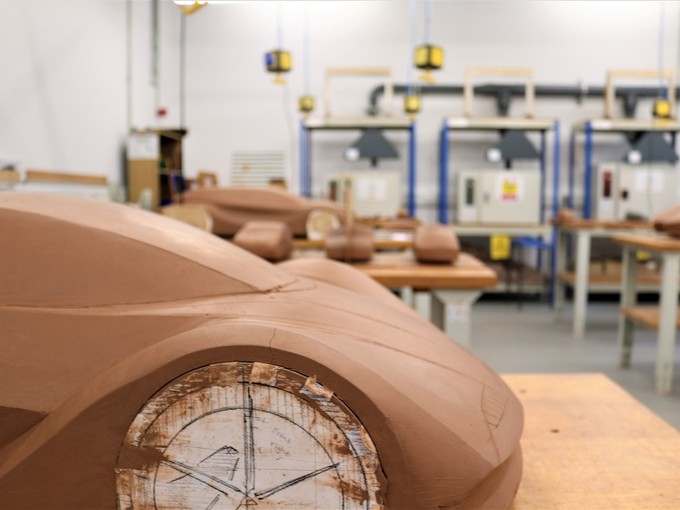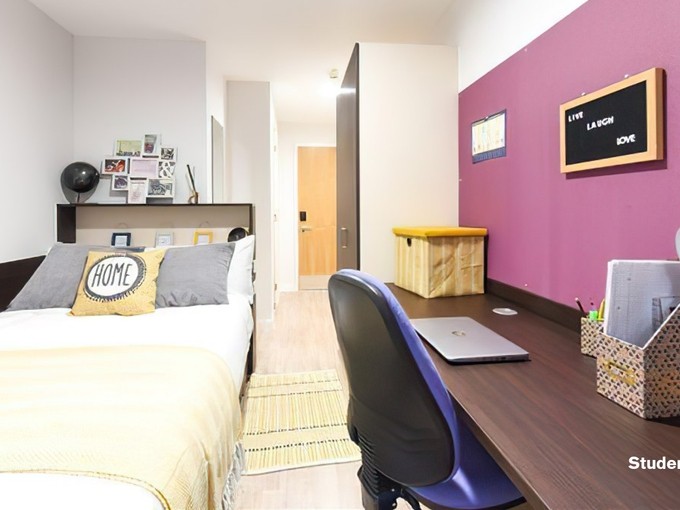Automotive and Transport Design (Full-time) (BA Hons)
This programme aims to equip you with comprehensive knowledge, practical skills and innovative approaches to sustainable automotive and transport design processes, developing a critical awareness of the environmental, social, legal and ethical framework within which you will work. The programme is highly successful and has produced several notable graduates who have gone on to lead their field.
The programme is delivered by an experienced team of established Automotive Designers, supported by visiting lecturers and practitioners and an experienced technical team. It includes a four-year BA programme with an optional industrial placement.
Traditional skills, including clay modelling, are taught alongside newer technologies such as computer-aided design (CAD), Virtual Reality and computer-aided manufacturing (CAM).
The programme aims to educate designers, clay and digital sculptors and hard modellers in the automotive and transport design industry (including yacht and motorcycle design) who are proficient in meeting the needs of both a contemporary and future environment.
By adopting a more comprehensive approach, you will be adaptive, resourceful and productive in meeting the challenges of the future of automotive and transport design with a mindset that will consider environmental, social and sustainability aspects.
Course details
- On-campus
- Full-time
- English
- Bilingual
Tuition Fees 2023/24 and 24/25
Home (Full-time): £9,000 per year
Overseas (Full-time): £13,500 per year
Why choose this course?
What you will learn
- Small student classes
- The Academic team consists of highly experienced Designers
- Live Design Projects
- State of the art facilities
- Industry contacts
- Chance to progress into a Master Degree Program
- Set by the sea in an area of outstanding natural beauty
Our courses have been designed to facilitate the development of a designer through the replication of a professional environment, encouraging graduates to approach the design challenge in the same way as a professional automotive designer.
Our graduates will be able to generate ideas around engineering packages, set new trends in terms of design language and learn about proportions. Link a particular design to a brand, imagine the mobility of the future in the most efficient, sustainable and attractive way, design forms of transport with an ‘inside out’ approach and most importantly translate a drawing into reality.
Compulsory
(20 credits)
(20 credits)
(20 credits)
(20 credits)
(20 credits)
(20 credits)
Compulsory
(20 credits)
(20 credits)
(20 credits)
(20 credits)
(20 credits)
(20 credits)
Compulsory
(40 credits)
(20 credits)
(60 credits)
Course Disclaimer
-
We listen to student feedback and insights from industry and from professionals to ensure that course content is high-quality and up-to-date, and that it offers the best possible preparation for your future career or study goals.
For this reason, there might be modifications to the content of your course over time, to keep up to date with changes in the subject area or in the sector. If a module is no longer running, we’ll make sure to keep you informed, and work with you to choose a different suitable module.
testimonial
Staff
Our People
You will be taught and supported by a wide range of professional staff and teams here to help you get the university experience you are looking for. Our teaching staff were ranked 2nd in Wales for assessments and feedback (NSS 2023) meaning the comments you get back from your work will help you learn. Our commitment to your learning has seen our students place us as Top 10 in the UK for Lecturers and Teaching Quality. Find out more about our academic staff who teach across our courses.
Accommodation

Automotive & Transport Design Facilities
Our Specialist Workshops Include:
Fibreglass layup and spray facilities, professional automotive clay tables and surfacing tools, traditional hand tools, laser cutting, milling, turning, CNC machining & 3D printing (Ultimaker, Objet & Stratasys machines) and digital scanning technologies (Artec, Roland).

Swansea Accommodation
Swansea has a huge student population, and the variety of accommodation available will leave you feeling spoilt for choice. Various purpose-built student accommodation providers provide accommodation in Swansea, and the accommodation team can guide you through your options. It will offer ongoing support throughout your time as a UWTSD student.
Further information
-
We are interested in creative people that demonstrate a strong commitment to art and/or design and therefore we welcome applications from individuals from a wide range of backgrounds. To assess student suitability for their chosen course we arrange interviews for all applicants at which your skills, achievements and life experience will be considered as well as your portfolio of work.
Our standard offer for a degree course is 120 UCAS tariff points. We expect applicants to have a grade C or above in English Language (or Welsh) at GCSE level, together with passes in another four subjects. Plus we accept a range of Level 3 qualifications including:
- Foundation Diploma in Art and Design, plus one GCE A-Level in a relevant academic subject
- Three GCE A-Levels or equivalent
- BTEC Extended Diploma in a relevant subject, with minimum grades of Merit
- International Baccalaureate score of 32
- Other relevant qualifications can be considered on an individual basis
Qualifications are important, however, our offers are not solely based on academic results. If you don’t have the required UCAS points then please contact the courses admissions tutor or email artanddesign@uwtsd.ac.uk as we can consider offers to applicants based on individual merit, exceptional work, and/or practical experience.
-
Assessment is carried out through coursework, both written and practical. There are no exams on this course. Students are formatively assessed throughout a module, summative assessment takes place at the end of a module. A variety of teaching and learning methods are used throughout the course which includes amongst others;
Informal Tutorials
These tutorials are held on a regular basis, across all levels. In Year 1 each student sees and discusses his / her work with a member of staff at each studio session, likewise in Year 2. Third and fourth year students tend to work more independently and sign up for tutorial when she/he feels the need arises. However, as a team, we ensure that every student in Year 3 is seen by at least one member of the academic staff each week. We pride ourselves on the fact that there is the opportunity to see staff as regularly as you may require.
Formal Tutorials
These are held twice a term with at least two members of staff. The work is discussed, practical and conceptual development, future intentions of the student etc. It is an opportunity for any issues/concerns by either party, to be raised. A written account of the tutorial is duplicated, one copy kept by the student the other stored in his / her records file.
Group critiques
These are held on a regular basis, across all levels, with one member of staff. They provide an excellent opportunity for students to share and exchange ideas with their peers in a structured manner in addition to valuable input from staff.
Informal & Formal presentations
The nature of the presentations varies according to the level: in Year 1 informal presentations are introduced halfway through the first semester in order to help students gain confidence in talking about their work to their peers and staff it is also usually part of the assessment at the end of each project. 2nd-year students are expected to give a Formal Presentation as part of their Professional Practice & Group Design Module and at the end of the year as part of their Major project. In Year 3 a Formal Presentation is part of the final assessment at the Degree Show
Exhibiting work
Again the nature of this varies within the context of the projects, the work to be assessed and the stage of the programme – it can range in formality from a public venue to the individual student’s desk space.
-
Our students have access to a diverse range of equipment and resources, which in most cases are sufficient to complete their programme of study. We provide the basic materials necessary for students to develop their practical work within our extensive workshop and studio facilities.
However, it is likely that art and design students will incur some additional costs to extend their investigation of their personal practice. For example, purchasing their own specialised materials and equipment, joining in optional study trips, and printing.
Students are expected to bring their own personal art and design equipment with them when they commence the course. We can advise on the correct equipment needed for your programme of studies and signpost appropriate suppliers if you wish to purchase essential items before or during your studies.
A basic ‘art and design kit’ will cost approximately £100 but you may well already have much of the equipment required so check with us first. Also, although we have extensive dedicated digital design studios (PC and MAC) for you to undertake your coursework you may wish to bring your own digital devices, again check with us first before making a purchase.
Placement
There will be an additional fee of £1800 for students who choose to study the programme with the optional year in industry placement.
-
You may be eligible for funding to help support your study. To find out about scholarships, bursaries and other funding opportunities that are available please visit our Scholarships and Bursaries section.
-
Students can also take up the opportunity to study a year in Europe, USA or Canada.
-
Graduates from our courses have found employment with some of the world’s most established names in manufacturing and design consultancy such as:
- ADIDAS
- ASTON MARTIN
- CALLUM DESIGN
- DAIMLER TRUCK USA
- ENVISAGE GROUP
- FUTURA DESIGN
- GORDON MURRAY DESIGN
- JAGUAR
- JAGUAR SVO
- ICONA DESIGN
- KISKA
- LAND ROVER
- LOTUS
- MCLAREN AUTOMOTIVE
- MORGAN
- PININFARINA
- PRIESTMAN GOODE
- PUMA
- RDM GROUP
- RENAULT
- ROLLS ROYCE
- SAIC
- TATA
- TRIUMPH
